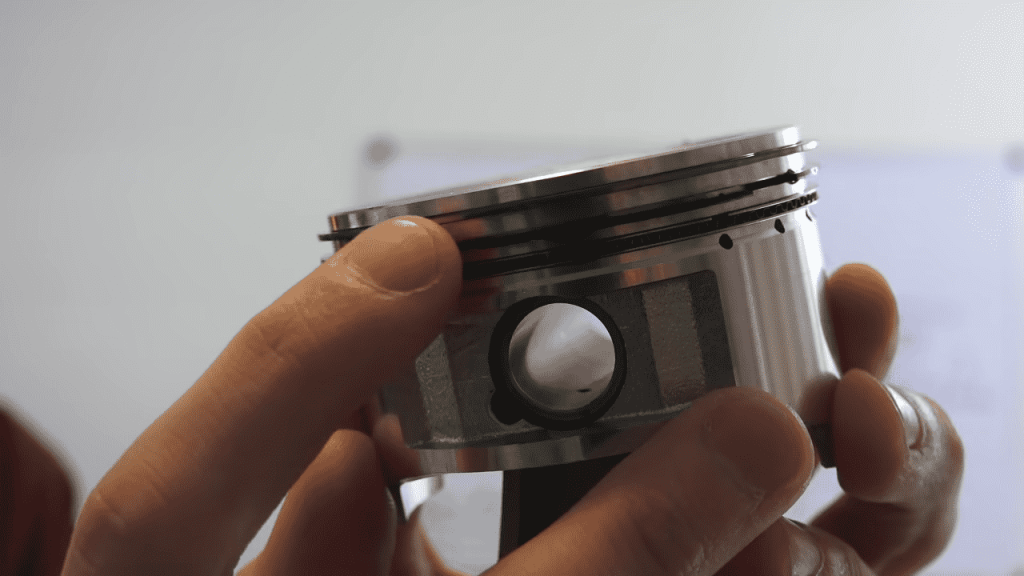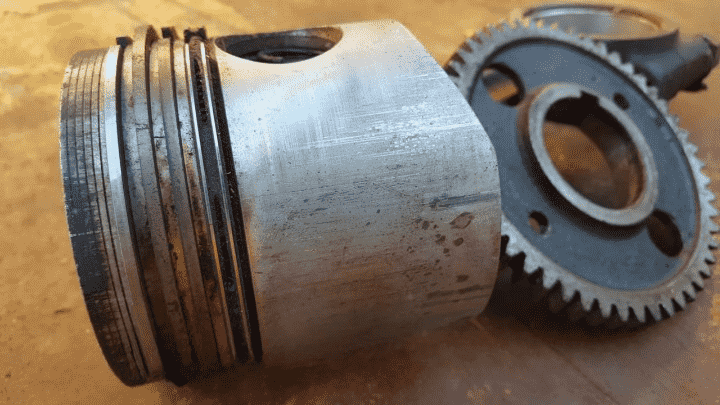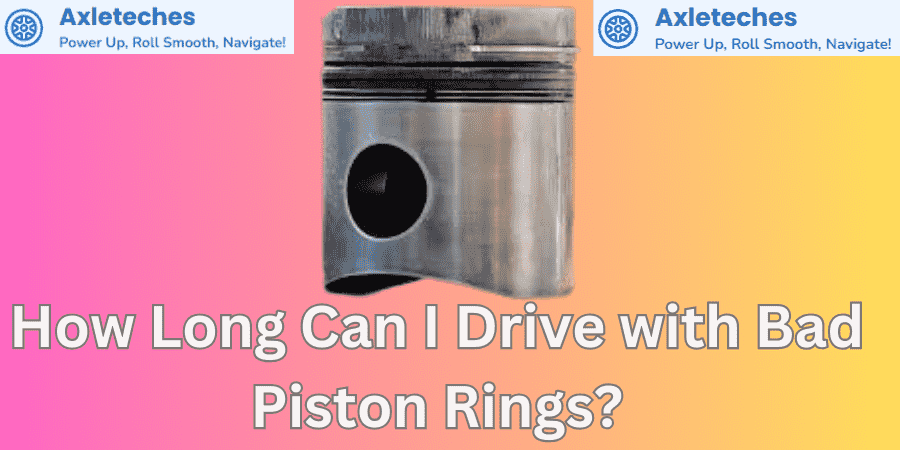You can drive with bad piston rings for a few hundred miles, but continuing beyond 5000 miles risks severe engine damage. It’s crucial to address the issue promptly. To drive with bad piston rings is to run a marathon with a sprained ankle; it may be possible but without any comfort. You may win the race and cross the finish line, but often at a tremendous cost that would have been more crushing than defeat. Some of the signs that are likely to force you to realize that your piston rings are worn out include increased oil consumption, reduced power output, or smoke from your exhaust. But the big question is: how long can you ‘get behind the wheel’ before things get desperate?
You might not notice them easily, but piston rings are quite large in terms of responsibility when it comes to your engine’s well-being. It is all relative – just as they are the guardians of power, efficiency, and oil use. When these rings start to fail you are out of luck, and while it may not be as dramatic as an engine seizing, it can happen. But don’t press the ‘Panic button’ just yet, let’s look into the likelihood of driving with bad piston rings and what can be done about the situation.
What Are Piston Rings?

Cylinder piston rings are one of the most vital subassemblies of an internal combustion engine. It covers and firmly fits around the pistons within the cylinders of the engine. Their primary functions include:
- Sealing the combustion chamber: This makes certain that the air-fuel mix burns to the optimum in order to result in maximum power.
- Regulating oil consumption: The piston rings ensure that oil does not get into the combustion chamber so that if it burnt it would affect the rest of the vehicle.
- Heat transfer: They aid in conducting heat from the piston to the cylinder wall so that the piston does not get extremely hot.
- There are typically three types of piston rings: compression rings, wiper rings, and oil control rings, their roles are as follows:
Symptoms of Bad Piston Rings

It will be very useful, to be able to notice symptoms of bad piston rings as early as possible. Here’s what you should watch out for:
Increased Oil Consumption
When your engine develops a habit of consuming a lot of oil regularly then it is a red signal. If your piston rings are worn out then oil finds its way into the combustion chamber where it is burnt, hence, regular oil consumption.
Blue Smoke from the Exhaust
Are you blowing blue or grey smoke out of your exhaust? This could well be due to the consumption of oil and the other symptoms point towards a failing piston ring.
Decreased Engine Performance
Your car could feel slower to pick up speed, or as a whole feel like it is not as responsive or powerful as it used to be. This is because the damaged rings can not compress the required pressure in the engine cylinder area.
Compression Loss
Regarding compression, for instance, if you apply the compression test and discover that one or more of the cylinders press lower pressure, then it is most likely that you have bad piston rings.
Rough Idling
Your car idling roughly or stalling might also be attributed to worn-out piston rings because the engine cannot sustain combustion.
How Bad Piston Rings Affect Your Engine

Driving with bad piston rings doesn’t just affect one part of your engine; it can lead to a cascade of issues:
- Decreased Power and Performance: The inability to seal your engines properly robs your power, making it inefficient when you are using your vehicle.
- Increased Wear on Engine Components: Other parts get used at a faster rate, especially because of the lack of the lubricant, and the huge heat that it can develop.
- Risk of Engine Failure: Long-term usage of bad piston rings means you continue driving with the problem and eventually cause total engine failure; a risky and costly blow.
Can You Drive with Bad Piston Rings?
In brief, the answer would be yes, but not without the tremendous exceptions. When driving with bad piston rings, you are exposing yourself to so much danger and the worst part is that the longer you use it, the worse the outcome will be.
The Risks Involved
As much as you can learn how to drive with bad piston rings, it is not easy or without resulting defects. Your engine’s performance is going to worsen steadily, and you are going to use up more oil and fuel than you usually do.
How Long You Can Drive
This depends on the degree of the damage done. In the early stages of Ubering, you could go for several weeks, if not months, without driving. However, if the rings are badly worn it could result in catastrophic failure of the engine in a few days at best.
Short-Term Solutions vs. Long-Term Fixes
In the worst case, thickening the oil, or adding motor additives may somewhat alleviate the manifestations for a while. However, these are only palliative actions and at some moment you will have to replace the piston rings.
What Happens If You Ignore Bad Piston Rings?

You can have bad piston rings in your engine, and that is similar to having a small hole in the dam; at some point, the worst will happen.
Progressive Damage to the Engine
The damage done by bad piston rings tends to increase with use and the longer the problem is left the worse it will get. This makes the cylinders worn out, the pistons damaged, and in the worst case, the engine block cracks.
Cost Implications of Delayed Repairs
What you thought to be a routine piston ring replacement could turn into a cycle engine overhaul leading to having to spend thousands of dollars.
Possible Safety Hazards
It might be convenient to putter along with a weak engine, but it’s reckless – at least for your car. The danger, which an owner facing a breakdown in the middle of a road or an accident, rises with the level of destabilization of the engine.
Temporary Solutions for Bad Piston Rings
If you’re not ready to replace the piston rings just yet, here are a few temporary fixes that might buy you some time:
Using Thicker Oil
Changing to a thicker weight oil will reduce the amount of oil that gets by the rings, but only temporarily addresses that issue.
Engine Additives
Some engine additives can seal the minor gap in the piston rings and thereby decrease oil consumption and smoke emission. However, this is but a stopgap measure at the very best.
Regular Oil Changes
Some of the problems caused by bad piston rings cannot be eradicated by a fresh and full supply of oil.
Conclusion
Riding a car with bad piston rings is like playing an uncertain game. It’s true that at times, the problem might not be very serious, but the longer you take to help sort it out, the more the harm done. From an increased consumption of oil to the possibility of having a fully seized engine, it is very lethal to overlook bad piston rings. If you’re experiencing the symptoms that have been highlighted in this piece, then it is high time you did something – whether using interim measures or arranging for replacement with the help of a knowledgeable mechanic.
FAQs
What causes piston rings to fail?
Piston rings can fail due to a variety of factors, including poor maintenance, overheating, and the use of low-quality oil.
How can I extend the life of my piston rings?
Regular oil changes, avoiding aggressive driving, and using high-quality oil can help extend the life of your piston rings.
Can bad piston rings damage other engine parts?
Yes, bad piston rings can lead to increased wear on other engine components and even cause total engine failure if left unaddressed.
Is it safe to drive with bad piston rings?
While it’s possible to drive with bad piston rings, it’s not recommended due to the potential for severe engine damage.
How much does it cost to replace piston rings?
The cost of replacing piston rings can range from $1,500 to $3,000, depending on your vehicle and location.

